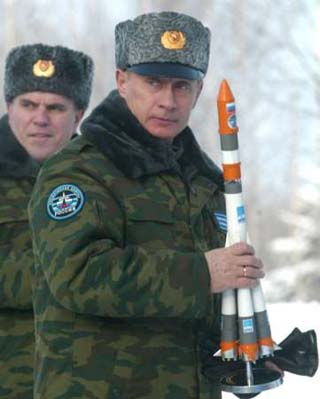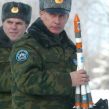
RUSSIA STILL SEES WEST AS PRIMARY ENEMY
Publication: Eurasia Daily Monitor Volume: 4 Issue: 110
By:

During an extended interview with Western and Russian journalists before this week’s G-8 summit in Germany, Russian President Vladimir Putin announced that if U.S. missile defense elements are deployed in Europe, “We will be forced to take adequate steps in response.” Putin elaborated: “New targets will appear in Europe. The systems that may be used to destroy these targets our military believe to be a potential threat to Russia — by ballistic missiles cruise missiles or something else — is a technical issue” (www.kremlin.ru, June 4).
This is the first time since the end of the Cold War that a Russian leader has openly threatened to target Europe with nukes. Previously, Putin and his predecessor Boris Yeltsin had proclaimed Russia to be an integral part of Europe. In 1994, Yeltsin and U.S. President Bill Clinton signed an agreement to de-target ballistic missiles of both countries away from each other. Later, a similar de-targeting agreement was signed with other nuclear states — Great Britain, France, and China. These agreements still stand, and Putin may have forgotten he must first legally revoke them before targeting.
In Russia, the Western fuss about Putin’s nuclear threats was received with some surprise. The chief of the Strategic Rocket Force, General Nikolai Solovtsov, told journalists, “If a decision is taken, we will be able to target U.S. missile defenses in Poland and the Czech Republic” (see EDM, February 21). Putin in fact said, “New targets will appear in Europe.” This clearly implies that other targets for nuclear strikes in Europe have been instituted before.
The United States and NATO are indeed Russia’s prime enemies. The Russian military continues to prepare to fight the West and performs major military exercises simulating such encounters. In 1999, after the NATO bombardments of Yugoslavia over Kosovo, the Russian military staged “Zapad-99,” a large-scale exercise with a scenario whereby NATO imposes an air/sea blockade of the Kaliningrad enclave and then begins an offensive with bombers and cruise missiles. The Russian conventional defenses are breached and, to resolve the situation, Moscow carries out a “preventive” nuclear attack using four long-range cruse missiles launched by strategic bombers. Two nuclear warheads hit targets in Western Europe and two in the United States. The decision to use air-launched nuclear cruise missiles is preferable, because even a limited launch of intercontinental ballistic missiles could trigger an immediate launch of U.S. ICBMs.
The Zapad-99 exercise ended with Russia victorious. Baffled by the limited preventive nuclear strike and faced with the choice to either begin an all-out global nuclear war or back down, NATO stopped its attack on Kaliningrad. After Zapad-99, Moscow accepted that preventive nuclear strikes would be the best way to stop a NATO attack that Russia’s weak conventional forces cannot repulse.
In May 2003 a Russian naval task force in the Indian Ocean conducted a war game that included the interception and sinking of a U.S. aircraft carrier group. Russian strategic bombers simultaneously simulated an attack with nuclear long-range cruse missiles on the U.S. base at Diego Garcia. This exercise was performed to demonstrate the capability to stop a U.S.-led attack against a Russian ally in the region.
Scenarios of a possible U.S. and NATO military invasion are not only routinely run during war games, but also constantly hotly discussed by Defense Ministry-connected think tanks and defense analysts in Moscow (Voyenno promishlenny kuriyer, April 14, 2004; Arms Control Today, April 2004). At the same time, there is a problem in finding a delivery system to use in a nuclear attack on Europe. Russian ICBMs are designated primarily to hit far-off U.S. and Chinese targets. During the Cold War intermediate ballistic missiles, like the Pioneer (SS-20), were deployed to target Europe, but the 1987 INF treaty destroyed all such weapons.
Today’s war games use long-range strategic cruise missiles as a substitute weapon to hit Europe. Putin considers the question of whether or not to use cruise missiles or something else in such attacks to be a technical, not legal, problem. In the interview Putin stated the intention to abrogate the INF treaty. This could solve the “technical problem” of how to nuke Europe. Putin added, “The INF issue is not connected directly to U.S. plans to deploy MD in Europe, but we will find responses to this threat and the other one” (www.kremlin.ru, June 4; EDM, February 21).
Putin’s threats are probably aimed at Europeans — the Poles and Czechs in particular — to frighten them into refusing to allow Washington deploy U.S. missile defense elements. In the same interview Putin proclaimed himself to be a “friend of the U.S.” Apparently, Putin believes in friendship based on threats.
Inside the Russian ruling elite open threats or the actual use of limited force are the trump cards in any negotiations. But in dealings with the West, Putin’s natural political tendencies constantly backfire, as do Putin’s jokes. In the interview, Putin announced that after the death of Indian spiritual and political leader Mahatma Gandhi, he “does not have a person to speak with.” That was evidently a joke, especially as Gandhi was killed in 1948. In the same dispatch Putin also said, “Ukraine is sliding into tyranny,” while in fact Ukrainians have decided to settle their political crisis through national elections. Was this another joke? Or does Putin hate free elections that much?




